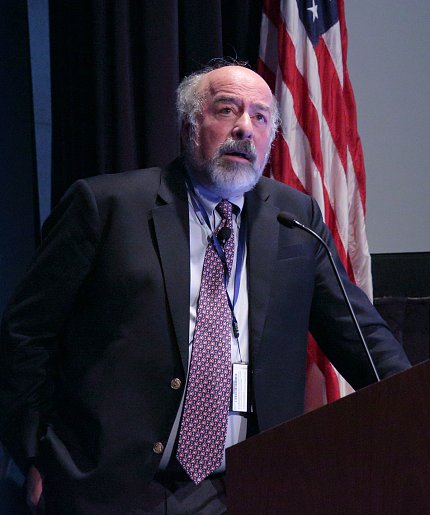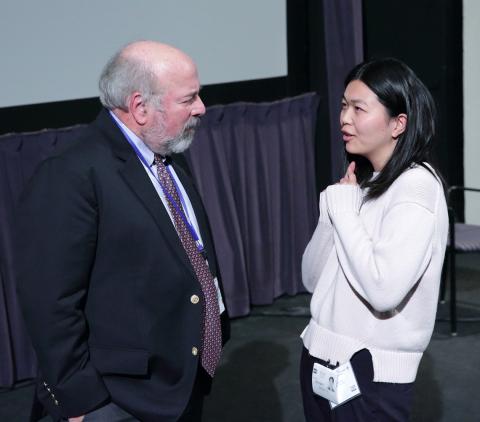Prevention Possible, However
Liver Cancer on Rise, Aflatoxin Contributes, Says Groopman

Photo: Bill Branson
There are few other chemical carcinogens as closely tied to causing cancer as aflatoxin, a product of mold, usually in corn, that is ubiquitous on planet Earth. First discovered in the United Kingdom in 1960, aflatoxin was soon thereafter linked to disease when it was implicated in the deaths of turkeys who had consumed moldy peanut meal. Identified as a cause of liver cancer from both experimental studies and epidemiology, aflatoxin remains a significant contributor to liver cancer in humans, which is now the second leading cause of global cancer deaths.
“Liver cancer is one of the most profoundly important cancers on our planet,” said Dr. John Groopman, the Anna M. Baetjer professor of environmental health sciences at Johns Hopkins University’s Bloomberg School of Public Health and professor of oncology and associate director for cancer prevention and control at Johns Hopkins School of Medicine and the Sidney Kimmel Comprehensive Cancer Center. He gave the biannual NCI Stars in Nutrition and Cancer lecture Mar. 21 in Lipsett Amphitheater.
Especially hard hit from liver cancer are China, Southeast Asia, sub-Saharan Africa and, recently, Central America, especially Guatemala, which has the highest rates of liver cancer in the western hemisphere. Some 750,000 people die of liver cancer each year, most before age 50, according to 2012 data, “and that’s clearly an underestimate,” said Groopman. “That number exceeds the population of Baltimore.” More than 80 percent of those deaths occurred in the economically developing world.
While aflatoxin plays a role in worldwide liver cancer morbidity and mortality, it is exacerbated by other causes of disease including infection (or co-infection) with hepatitis B and C viruses, which dramatically accelerate the chances of acquiring the disease. Obesity, type 2 diabetes, non-alcoholic fatty liver disease and non-alcoholic steatohepatitis also contribute to the rise.
“There are about 500 million HBV carriers worldwide,” said Groopman. “One hundred million people are expected to die in this century from [liver cancer].”
In the U.S., liver cancer is the most rapidly rising solid tumor in both men and women, said Groopman, likely due to an “astonishing” resurgence of fatty liver disease caused by alcohol abuse.
“I wish we understood the mechanism [causing fatty liver disease], which affects about 30 percent of the population, but is rising,” he continued. “There had been a very dramatic decline in chronic alcoholism in the U.S. in the 1960s and 1970s, but it’s on the rise again, along with opiates. It’s a huge problem in rural America.”
The border counties of south Texas have the highest rates of liver cancer in the U.S., but over the next 15-20 years, liver cancer rates are projected to rise in Hispanic and African-American communities, Groopman said.
How to counter this global threat? Groopman and his colleagues have been studying liver cancer hotspots, especially in coastal China, since the early 1980s and have discovered both urinary biomarkers and natural products that can arrest progress of the disease.

Photo: Bill Branson
For 30 years, they have focused on Qidong, in Jiangsu province, where the median age of liver cancer death is the late 40s. Here, a “diabolical parallelism” of exposure to both aflatoxin and hepatitis B virus, often before age 1, is a major public health problem.
“Aflatoxin exposure can occur in utero if the mother eats exposed food,” noted Groopman. “We can detect [carcinogenic] mutations in plasma up to 20 years before diagnosis of disease.”
He and colleagues are documenting a two-pronged approach—reducing consumption and chemical detoxification—in high-risk human populations.
An MIT-trained toxicologist, Groopman, who also trained at NCI’s Division of Cancer Cause and Prevention years ago, and his team focused on natural products as interrupters of the metabolic path by which aflatoxin produces dangerous DNA adducts that promote cancer.
“The challenge was finding foods with enough compounds to modify protective enzymatic pathways,” he said. “Our colleagues found that broccoli turned out to be most useful.”
If you bite into a raw stalk of broccoli, it tastes bitter. The chemical cause of that bitterness is glucoraphanin, a beneficial chemical. No part of broccoli contains more glucoraphanin than the seed.
In research supported by NIH, in particular NCI, this international team of scientists has been working to systematically deploy their basic science discoveries to intervention trials in high-risk populations. “These proof-of-principle trials represent the type of team science needed to develop cancer prevention that is both economically and culturally appropriate for these communities,” said Groopman.
While these trials have been under way, “we are going to listen to the cancer registry data,” he assured.
Already, liver cancer incidence in Qidong is dropping among the younger population, Groopman reported, but it’s unlikely due to HBV vaccination because this was introduced there in 2002.
“Deng Xioping [who led the People’s Republic of China from 1978 to 1989] allowed farmers to make a profit, so the local agriculture switched from corn to rice as a staple commodity.” The reduction in aflatoxin exposure has been about 4,000 percent.
“It’s like quitting smoking to reduce lung cancer,” said Groopman. “We should never forget that primary prevention can have profound benefits.”
Besides China, aflatoxin exposure has been linked to acute toxicities in communities suffering from drought and poor crops, impairment of child growth and development and cancer in many countries across the globe.
Aflatoxin also plays a putative role in rising rates of gall bladder cancer on the west coast of South America; this has been documented in studies led by NCI intramural investigators.
Concluding with an endorsement of global studies as a worthwhile investment for the U.S., he noted, “All humans respond to aflatoxin in the same way.”
The full talk can be seen at https://videocast.nih.gov/summary.asp?Live=21944&bhcp=1.
